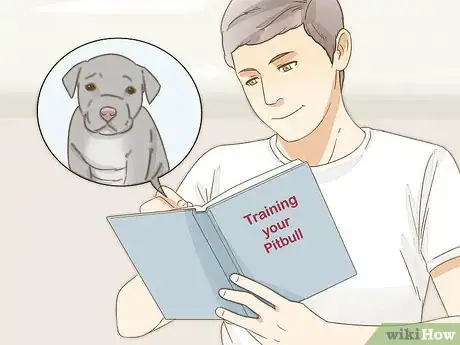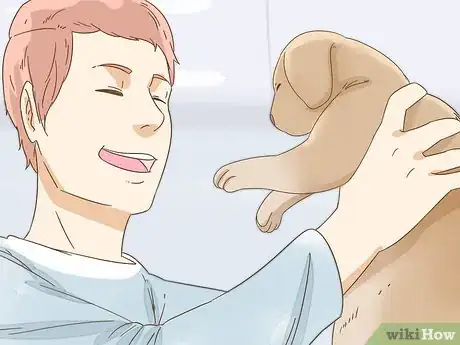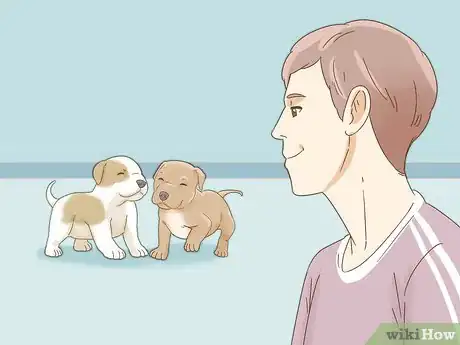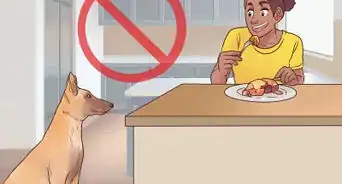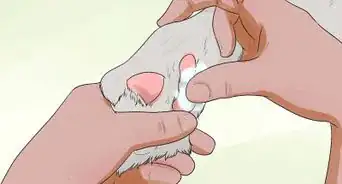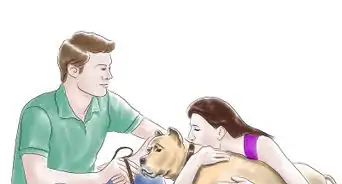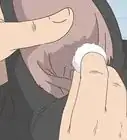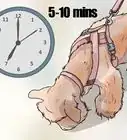This article was co-authored by Brian Bourquin, DVM. Brian Bourquin, better known as “Dr. B” to his clients, is a Veterinarian and the Owner of Boston Veterinary Clinic, a pet health care and veterinary clinic with three locations, South End/Bay Village, the Seaport, and Brookline, Massachusetts. Boston Veterinary Clinic specializes in primary veterinary care, including wellness and preventative care, sick and emergency care, soft-tissue surgery, dentistry. The clinic also provides specialty services in behavior, nutrition, and alternative pain management therapies using acupuncture, and therapeutic laser treatments. Boston Veterinary Clinic is an AAHA (American Animal Hospital Association) accredited hospital and Boston’s first Fear Free Certified Clinic. Brian has over 19 years of veterinary experience and earned his Doctor of Veterinary Medicine from Cornell University.
There are 16 references cited in this article, which can be found at the bottom of the page.
wikiHow marks an article as reader-approved once it receives enough positive feedback. This article received 19 testimonials and 91% of readers who voted found it helpful, earning it our reader-approved status.
This article has been viewed 714,645 times.
Of the many breeds of dog, few have been as negatively stereotyped as aggressive like the pitbull. This is an unfair, inaccurate characterization of a breed that can be incredibly gentle and loving, especially when raised correctly as puppies. Taking care of a pitbull puppy is similar to taking care of puppies of another breed. You'll need to feed, nurture, and train your puppy to become a good canine citizen.[1]
Steps
Training Your Pitbull Puppy
-
1Start training your puppy early. You should begin reading up on training your pitbull before you get him. This way, you can immediately train and socialize your puppy once you bring him home. If you get your puppy from a good breeder, the breeder might have started socializing your pitbull. This way, your puppy is already exposed to new situations, sounds, people, and animals.[2]
- Consider hiring a qualified, experienced dog trainer to interact and teach your dog manners.[3]
-
2Train your puppy. Teach your puppy a few basic commands (like "come," "sit," "stay"). This way, when you notice your puppy engaging in bad behavior, you can immediately redirect his attention. For example, if you notice your puppy running up and jumping on someone, you can quickly command him to "come." He should stop jumping up on the person and come to you instead.[4]
- Teaching your puppy a few simple commands can also keep him safe. If he's about to do something dangerous, like run into traffic, you can command him to "sit" or "stay" so that you can reach him.
Advertisement -
3Teach your puppy to stop biting. Many puppies will mouth or nip when playing. They need to learn bite inhibition, especially when playing so they know it's never okay to bite. There are several ways you can teach bite inhibition. But, often just saying “ouch” firmly and then stopping puppy play signals to your puppy that biting is not acceptable.[5]
- Instead of letting your puppy play with your hands, offer toys that you can teach your pitbull to release.
- You can also place your puppy in time out immediately after nipping. This will help him settle down and tell him that biting is inappropriate.
-
4Use positive reinforcement. When you're training, never get mad at your pitbull. Animals don't understand punishment and will instead learn to fear you. Puppies will make mistakes when learning new things, so be patient. You should always look for a reason to praise your puppy, even if only for small steps or achievements.[6]
- For example, give your puppy a treat when he's calm instead of punishing him when he's being hyper.
-
5Let your puppy know you're in control. You may want to make your puppy repeat certain actions or commands, especially if he didn't obey. This signals to your pitbull that he didn't do something correctly and needs to keep trying until he succeeds. Let him rest once he gets close to completing the command. Give your pitbull plenty of chances to follow your commands.
- Your puppy should get used to you handling his feet, ears, tail, and body. This signals that you're in control and will make it easier to groom your puppy, administer medications, and clip his nails.
Nurturing Your Pitbull Puppy
-
1Microchip and place a collar on your puppy. Get an identifying microchip inserted below your pitbulls skin and put a collar with an identification tag around his neck. These will make it easier to locate your puppy if he gets lost. Pitbulls are good at escaping their yards, so microchipping is important. Consider asking humane societies to microchip, since some offer low-cost microchipping.[7]
- Make sure your yard is secure, ideally with at least a six foot solid fence. Chain link fences can be climbed and they are not a visual deterrent to other animals or humans bothering your pet.
-
2Feed your pitbull a nutritious diet. Talk with your veterinarian about choosing a high-quality food for your puppy. Avoid commercial foods that list low-quality ingredients like meat by-products and grains.[8] Instead, choose one that immediately lists a meat.[9] Offer your puppy several regular meals throughout the day instead constantly leaving a full dish of food out.[10]
- Read the package or ask your vet about a specific amount of food to feed your puppy each day.
-
3Get your puppy regular medical care and vaccinations. Talk with the veterinarian about spaying or neutering your puppy to prevent unexpected litters and ask about treating your puppy for worms. Your puppy will also need the basic vaccinations that all puppies get, starting at 8 weeks old. A booster should be given 3 or 4 weeks later. Any other vaccines that your vet recommends will need to be boosted every year.[11]
- Your puppy should have his first veterinary exam before you bring him home. After that, make sure he sees the vet every year.
- Check local laws to determine a rabies vaccine requirement. Most rabies vaccines are started at 12 weeks old and Lyme disease vaccines begin at 9 weeks followed by a booster 3 to 4 weeks later.
-
4Get your puppy plenty of exercise. Try to take your puppy for short walks (less than 15 minutes) if he's less than 3 months old. You'll want to walk him at least twice a day, even as a puppy. Exercise is important to keep him healthy, burn energy, and make him happy and engaged. If you can, let your puppy exercise in an area with lots of space. This gives him the freedom to run around.
- Playing fetch is a great way to interact with your puppy while he gets some exercise.[12]
-
5Keep your puppy mentally stimulated. Offer your puppy kibble, toys, and treats while you do training exercises. For example, you might bury treats and let your pitbull dig them up. This will let him use up energy and engage his brain. Or, you can let him play with puzzle toys that release kibble. This will keep your pitbull from becoming bored and destructive.[13]
- Pitbulls are highly intelligent and can become destructive if left with nothing to do. Don't leave your puppy alone for too long. If you must, leave him in an enclosed area like a crate or pen with plenty of toys.
Socializing Your Pitbull Puppy
-
1Introduce your puppy to new people and situations. Start introducing your pitbull to different people and animals as early as you can. This will help your puppy get used to all sorts of people and animals.[14] The best time to start socializing your puppy is when he's around 3 to 5 weeks old to when he is 14 to 18 weeks old. During this time, your puppy easily learns and absorbs new information which can make him confident later in life.
- Give your pitbull treats as a reward for greeting people. You can let others feed your puppy the treats so that he associates people with good things.
- Treats can also keep your puppy's attention around loud or possibly frightening situations like traffic, skateboards and bicycles.
-
2Make sure your puppy is comfortable. Your pitbull puppy might be frightened when meeting new people or encountering new situations. Put him at ease by starting with calm, comfortable situations before gradually introducing more exciting situations. Watch your puppy for signs that he's content. Never force your dog into an interaction that seems to overwhelm or frighten him.[15]
- For example, if your puppy appears frightened by meeting new people out in public, try introducing people to him at home. Your puppy may be more relaxed in this environment. Eventually, you can expose him to new things outside of the home.
-
3Enroll your pitbull in socialization classes. One of the best ways to socialize your puppy is to take a puppy socialization class with your puppy.[16] You could find a responsible pitbull dog group, canine good citizen program, or dog therapy training program. These classes can give you skills you need to teach your puppy commands and help your puppy interact with other dogs.
- You can find available programs through community education centers, humane societies, and large pet stores. Your veterinarian may also be able to recommend local classes.[17]
-
4Supervise interactions with other dogs. You should always watch your puppy when he's playing with other puppies or dogs. If you notice a problem, stop the behavior before they start fighting. For example, play has moved too far towards fighting if one puppy is biting another's skin,[18] especially if the biting puppy is shaking his head and pinning the other to the ground.[19] Once you stop the fighting and the puppies calm down, reward them and let them play again.
- To easily interrupt fighting, keep both puppies on six-foot leashes. Or, keep blast horns and squirt bottles around to quickly interrupt fighting.
- If your puppy doesn't often fight with other puppies, you can practice commands. For example, call your puppy to you and reward him when he obeys.
Expert Q&A
Did you know you can get expert answers for this article?
Unlock expert answers by supporting wikiHow
-
QuestionAre there any ingredients I should look out for when feeding my Pitbull puppy?
 Brian Bourquin, DVMBrian Bourquin, better known as “Dr. B” to his clients, is a Veterinarian and the Owner of Boston Veterinary Clinic, a pet health care and veterinary clinic with three locations, South End/Bay Village, the Seaport, and Brookline, Massachusetts. Boston Veterinary Clinic specializes in primary veterinary care, including wellness and preventative care, sick and emergency care, soft-tissue surgery, dentistry. The clinic also provides specialty services in behavior, nutrition, and alternative pain management therapies using acupuncture, and therapeutic laser treatments. Boston Veterinary Clinic is an AAHA (American Animal Hospital Association) accredited hospital and Boston’s first Fear Free Certified Clinic. Brian has over 19 years of veterinary experience and earned his Doctor of Veterinary Medicine from Cornell University.
Brian Bourquin, DVMBrian Bourquin, better known as “Dr. B” to his clients, is a Veterinarian and the Owner of Boston Veterinary Clinic, a pet health care and veterinary clinic with three locations, South End/Bay Village, the Seaport, and Brookline, Massachusetts. Boston Veterinary Clinic specializes in primary veterinary care, including wellness and preventative care, sick and emergency care, soft-tissue surgery, dentistry. The clinic also provides specialty services in behavior, nutrition, and alternative pain management therapies using acupuncture, and therapeutic laser treatments. Boston Veterinary Clinic is an AAHA (American Animal Hospital Association) accredited hospital and Boston’s first Fear Free Certified Clinic. Brian has over 19 years of veterinary experience and earned his Doctor of Veterinary Medicine from Cornell University.
Veterinarian
-
QuestionHow much are you supposed to feed a pitbull puppy?
 Pippa Elliott, MRCVSDr. Elliott, BVMS, MRCVS is a veterinarian with over 30 years of experience in veterinary surgery and companion animal practice. She graduated from the University of Glasgow in 1987 with a degree in veterinary medicine and surgery. She has worked at the same animal clinic in her hometown for over 20 years.
Pippa Elliott, MRCVSDr. Elliott, BVMS, MRCVS is a veterinarian with over 30 years of experience in veterinary surgery and companion animal practice. She graduated from the University of Glasgow in 1987 with a degree in veterinary medicine and surgery. She has worked at the same animal clinic in her hometown for over 20 years.
Veterinarian
-
QuestionHow often do you wash a pitbull?
 Pippa Elliott, MRCVSDr. Elliott, BVMS, MRCVS is a veterinarian with over 30 years of experience in veterinary surgery and companion animal practice. She graduated from the University of Glasgow in 1987 with a degree in veterinary medicine and surgery. She has worked at the same animal clinic in her hometown for over 20 years.
Pippa Elliott, MRCVSDr. Elliott, BVMS, MRCVS is a veterinarian with over 30 years of experience in veterinary surgery and companion animal practice. She graduated from the University of Glasgow in 1987 with a degree in veterinary medicine and surgery. She has worked at the same animal clinic in her hometown for over 20 years.
Veterinarian
Warnings
- Always directly supervise any dog with children. Make sure the age-appropriate children know how to properly interact with the puppy or dog. You may want to keep the puppy on a leash so you can easily remove the puppy from the children, if needed.⧼thumbs_response⧽
- Never hit your dog. Violence toward the puppy will only create fear and distrust. This can cause your puppy to become aggressive. If you're having trouble disciplining your puppy, get the help of a professional trainer.⧼thumbs_response⧽
References
- ↑ Brian Bourquin, DVM. Veterinarian. Expert Interview. 20 December 2019.
- ↑ Effects of dog-appeasing pheromones on anxiety and fear in puppies during training and on long-term socialization. Sagi Denenberg, DVM and Gary M. Landsberg, DVM, DACVB. JAVMA. 2008
- ↑ https://apdt.com
- ↑ https://www.aspca.org/pet-care/virtual-pet-behaviorist/dog-behavior/training-your-dog
- ↑ www.whole-dog-journal.com/issues/13_6/features/Bite-Inhibition_16232-1.html
- ↑ http://www.humanesociety.org/animals/dogs/tips/dog_training_positive_reinforcement.html?referrer=https://www.google.com/
- ↑ http://americanpitbullfoundation.com/microchipping-your-bully/
- ↑ Brian Bourquin, DVM. Veterinarian. Expert Interview. 20 December 2019.
- ↑ www.dogfoodadvisor.com
- ↑ Brian Bourquin, DVM. Veterinarian. Expert Interview. 20 December 2019.
- ↑ https://www.aspca.org/pet-care/dog-care/general-dog-care
- ↑ https://www.aspca.org/pet-care/virtual-pet-behaviorist/dog-behavior/enriching-your-dogs-life
- ↑ https://www.aspca.org/pet-care/virtual-pet-behaviorist/dog-behavior/enriching-your-dogs-life
- ↑ www.aspca.org/pet-care/virtual-pet-behaviorist/dog-behavior/socializing-your-puppy
- ↑ https://www.aspca.org/pet-care/virtual-pet-behaviorist/dog-behavior/socializing-your-puppy
- ↑ Evaluation of association between retention in the home and attendance at puppy socialization classes M. M. Duxbury, DVM; J.A. Jackson; S. W. Line, DVM, PhD, DACVB; and R. K. Anderson. JAVMA. 2003
- ↑ http://www.akc.org/events/training-clubs/
- ↑ https://www.cesarsway.com/dog-training/dog-socialization-training/dog-not-playing-nice
- ↑ www.thedodo.com/community/MarcBekoff/theres-nothing-simple-about-do-768002870.html
About This Article
To take care of your pitbull puppy, start training it early so that bad behavior doesn’t become a habit. Begin by teaching the puppy basic commands such as “sit” and “come” to help you redirect its attention if it is doing something naughty. If the puppy nips you, say, “Ouch,” firmly and stop playing with it, which will show it that biting is not acceptable. You can also enroll your puppy in socialization classes to get it used to being around other dogs. For tips from our Veterinary reviewer on how to introduce your pitbull puppy to new people or situations, read on!

